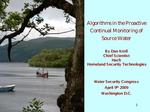Description
This powerpoint presentation begins by providing a brief overview of solving water quality problems in Texas, tracking fecal pollution, total maximum daily loads (TMDLs) and bacterial source tracking (BST), and targeting E. coli.Specific study objectives include: determine human and animal sources ofE. coli fecal pollution of watersheds;develop publicly available BST libraries;evaluate method precision and accuracy; compare BST methods; and,provide a foundation for future BST studies. The experimental approach included the following: E. coli isolation from samples using the samemedia for compliance water monitoring; U.S. Environmental Protection Agency (USEPA) Method 1603 – modified mTEC medium;confirmation of ß-D-glucuronidase activity ofisolates using NA-MUG; and,no broth enrichment or clinical media, avoidselecting different populations of E. coli. Presentation conclusions indicate the following: four-method composite data set had thehighest accuracy;two-method composites better than anysingle method – ERIC-RP or ERIC-ARA; moderate accuracy and confidence inresults – need to improve; and,Lake Waco and Belton Lake, wildlife leadingpollution source (~40%), while cattle were~20%. Includes tables, figures.
Product Details
- Edition:
- Vol. – No.
- Published:
- 11/01/2008
- Number of Pages:
- 48
- File Size:
- 1 file , 3.3 MB
- Note:
- This product is unavailable in Ukraine, Russia, Belarus





